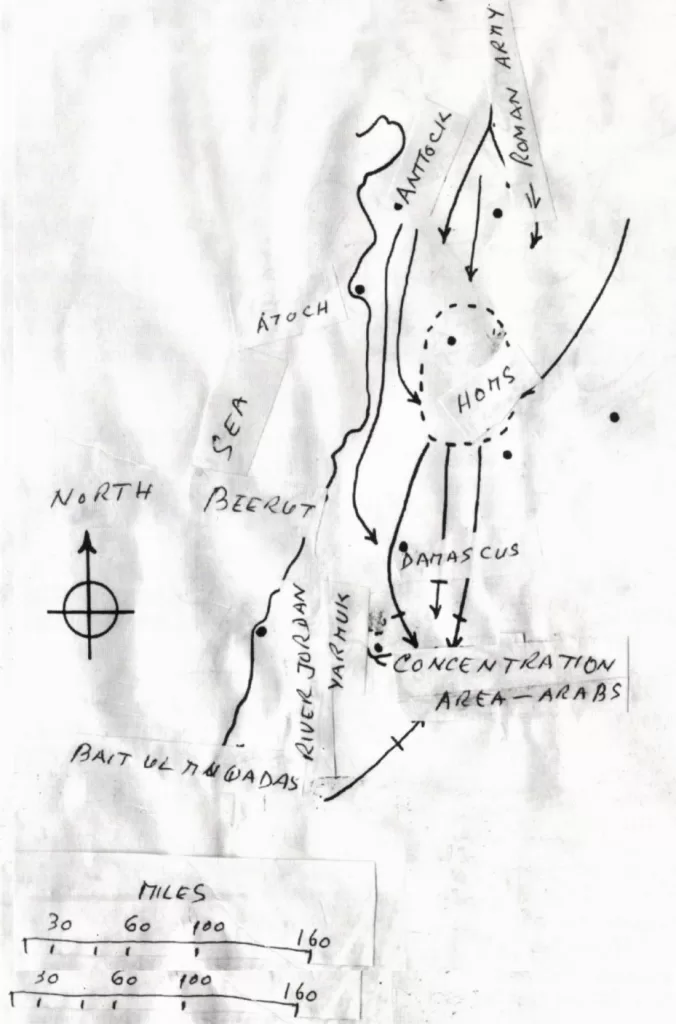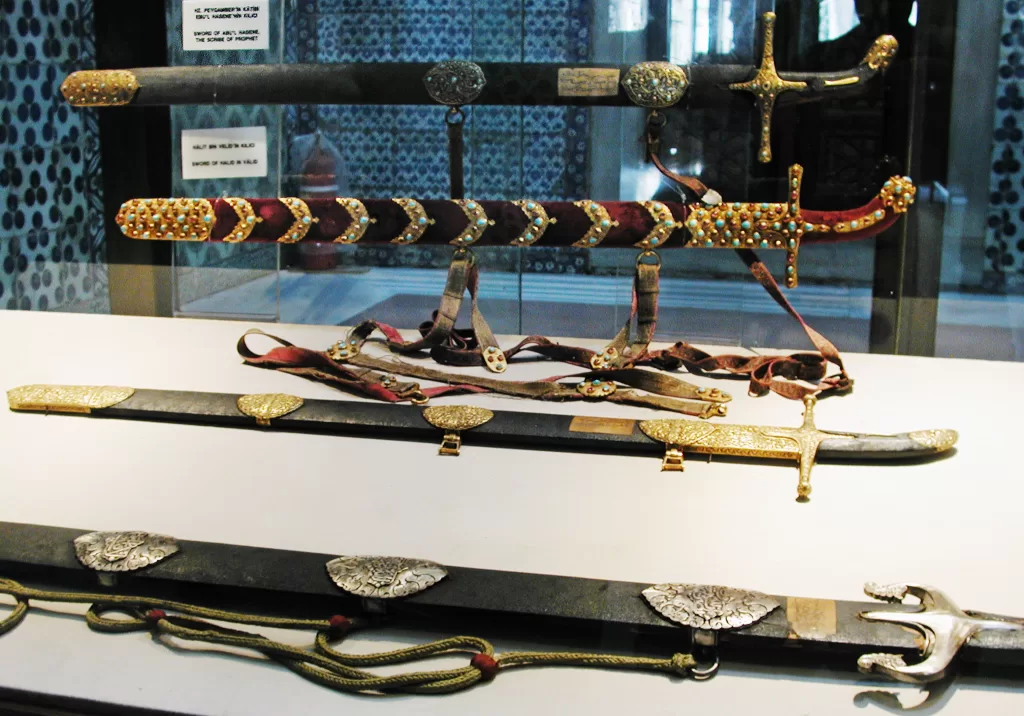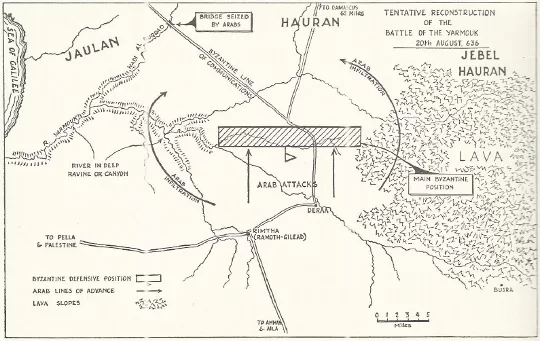Remember thy Lord inspired
The angels (with the message);
“I am with you; give
Firmness to the Believers;
I will instill terror
Into the hearts of the unbelievers;
Smite ye above their necks
And smite all their
Finger tips off them.”
(Surah Al-Anfal, Para 8. Ayat 12)
Introduction
It was a classic defensive offensive battle in which the Arab commander (KHALID BIN WALEED) inflicted crushing defeat on the over three times, well armed, superior Roman Army. The victory was achieved by employing superior strategy and tactics. The Arab commander had forced the enemy to fight on the ground of his choice and left difficult ground for the enemy. The other contributing factors were leadership, high morale and unblemished faith in ALLAH.
After the defeat in the battle of AJNADIN in 634 AD, the Arab forces had occupied DAMASCUS, HOMS and many other towns of SYRIA and JORDAN. The Roman Emperor was highly upset and decided to recover the lost territories by raising a large army.
Relative Strength
According to various historians the Roman army was one hundred and fifty thousand strong. About thirty thousand Roman soldiers on oath had tied themselves in chains for fighting till the end. The Roman army had 30000 infantry, 30000 horsemen and a few thousand archers. They were armed with the imperial weapons, wore steel helmets and carried shields to ward off sword and lance attacks. About 60000 BENI GHASSAN Arabs (Christians) were also present in the Roman army. JABALA had embraced ISLAM but during TAWAF around the KAABA, a Bedouin Arab had unintentionally stepped on his silken ahram which got untied. JABALA was haughty and got furious and contemptuously and vigorously slapped him. The Bedouin arab reported the incident to Hazrat OMAR who ordered that the Bedouin arab would slap JABALA to avenge his insult. JABALA renounced ISLAM and secretly left, once again accepted Christianity and joined the Romans.
The strength of the Arab army was about 40000 (15000 camel riders, 20000 horsemen and about 5000 archers) mostly armed with their personal weapons and carried little reserve weapons or rations.
THRODORUS was the C-in-C of the Roman army whereas QANATIR (a Russian prince), JREER and JABLA were his other senior commanders who commanded their respective forces. The Roman emperor had ordered that without flanking and enveloping fast movements the scattered Arab forces on four different fronts should be destroyed and driven back into the Arabian desert. He was certain that with overwhelming strength and fast movements of various Roman forces surprise would be achieved for eventual success.
Hazrat ABU ADABA (the C-in-C appointed by Hazrat OMAR in place of KHALID) had received information about the Roman army strength and their plan of offensive operation against the Arab forces operating in different areas. Arab patrols, friendly locals and travelers were providing information. In the Arab army there were about one thousand ASHABAS (close friends of the Holy Prophet – Pbuh) and about one hundred veteran soldiers who had participated in the battle of BADR under the command of the Holy Prophet (Pbuh).
The Arab C-in-C, in view of the situation, held a council of war in which all the senior commanders (KHALID BIN WALEED, UMRO-BIN-ALAS, SHERJEEL BIN HASNA, ZUBAIR BIN AWAM, ZARRAR BIN AZWAR, ABDULREMAN BIN ABU BAKR, FAZAL BIN ABASS, YAZID BIN ABU SUFIAN, MIQDAD, QAQA BIN UMRO, ABDULLAH BIN OMAR, AKRAM BIN ABUJEHAL, QAIS BIN HEERA and some others) were present. The C-in-C described the situation and concluded that the Roman army would soon advance from their concentration areas for offensive operation. He asked his senior commanders about their views on how to meet the Roman onslaught.
Most of the commanders recommended to fight in the present open area. In the end the C-in-C asked KHALID’s opinion who gave the following recommendations for the impending battle:
- In the present open area which had towns, fertile area, some hilly terrain, where tracks linked with various towns, fighting would be disadvantageous because outflanking, infiltration and enveloping would not be possible with large size mounted infantry and cavalry.
- The conquered area of 200 mile should be vacated and handed over to the locals by returning their received JAZIA. When the Arab forces had recaptured the area we would accept JAZIA if the locals desired to remain under our protection.
- From QASARIA and PALESTINE area (still under the sway of the Romans) their garrisons would be able to reinforce the main Roman army.
- By withdrawing 200 miles the race to our L of C would be shorter for supplies and reinforcements.
- In the narrow valley of the YARMUK the big Roman army would not be able to carry out outflanking movement and also for battle full deployment would not be possible whereas own forces being light would be able to move with speed over difficult terrain.
- Our mounted patrols (both fighting and long range ambush parties) would be able to move faster from the right over the lava strewn area (for infantry and for heavy Roman soldiers or riders it would be difficult to negotiate) strike the enemy L of C from the rear.
- In the west most of the narrow tributaries of the river YARMUK and the rocky broken area would become formidable obstacles for the movement of the enemy force.
- Most of the water (drinking and for animals) would remain under control of the Arabs.
- During these months of the year windstorms carrying heaps of dust would often intensively blow from south to north which would create problems for the movement of the Roman army.
All the commanders accepted the recommendations of KHALID and ABU ABADA allowed him to conduct the battle according to his plan. The Arabs vacated the 200 miles of conquered area and paid back the received JAZIA to the concerned people but most desired them to come back as they would like to remain under their protection because the Romans always treated them as third class citizens or slaves.
Under the protection of one strong patrol the entire Arab army withdrew by bounds and without any loss reached their concentration area during July 639 AD. Soon after the Roman army also pitched their tents in front. The Romans were happy to occupy the vacated area of 200 miles without fighting. They thought the Arabs were afraid to fight their strong army and had retired in fright. The Roman army felt happy to concentrate in the narrow ground crisscrossed by gorges and narrow passes/defiles. There was no strong move to commence battle, but decided to remain in defence as they considered themselves safe.

The Arab army was receiving reinforcements consisting of volunteers in small numbers. KHALID dispatched strong fighting patrols and ambush parties from the flanks crossing difficult terrain, inflicted casualties on the enemy and captured their supply convoys. The bold actions of the patrols and ambush parties had adversely affected the morale of the soldiers and they were feeling the pinch of supplies because the L of C was not considered safe.
The Roman C-in-C offered huge sums and valuable presents to the Arab commanders and even soldiers were promised cash in order to induce all of them to return to the desert. The Romans had captured some Arab soldiers and threatened to kill them but KHALID, with his bold infiltration tactics, was able to rescue the prisoners in the presence of a large Roman escort. The Roman C-in-C continued hurling threats of vengeance with horrid consequences and at night the Roman parties also raided the Arab camps but they were repulsed with losses and left behind some dead bodies.
The Roman Emperor was not happy with the passive attitude of the C-in-C and ordered him to commence all out war. KHALID’s intelligence also received this information and immediately conveyed the same to his Chief. On 30 August the Romans decided to attack.
KHALID also deployed his forces for all round defence, for aggressively meeting the attacking enemy troops. Archers were deployed on higher ground and mounted archers were also dispatched who created havoc in the advancing enemy lines and were successful pushing them back.
Behind the position of the archers some stores of ration and spare arms were located which were defended by the Arab women who had accompanied the Arab forces. They were employed for cooking, looking after the wounded and singing warrior songs and hymns to raise morale of the soldiers. The Arab women also boldly defended their area with arches and using bamboos of the tents when an enemy party had infiltrated into their area.
Because the strength of the army was far less therefore KHALID created a separate force of 5000 riders and further divided them in ten parts. They were sent deep behind the deployed area. They were commanded by bold commanders who were instructed to join the main body by kicking lot of dust. Each party was to appear allowing an interval of few hours. This deception forced the enemy into believing that the Arab army was getting reinforcements. The Romans were obviously demoralized. A few Arab parties infiltrated into the enemy and appeared deep into the enemy position. This Arab party captured the enemy water resource and occupied the bridge of BANAT YACOUB and northwards to BAALBEK. This was a great blow.
The Roman C-in-C sent JABLA with his force to attack on narrow front and challenge the Arab warriors. KHALID selected sixty bold swordsmen, archers and lancers, including FAZAL BIN ABAS, ZARRAR BIN AWAM, ABDULLAH BIN ABU BAKR, SUBIR BIN AWAM, ABDULLAH BIN OMAR, FARAH BIN UMAIR, RABIA BIN AMIR, ASAM BIN OMAR, YAZID BIN ABU SUFIAN and some other stalwarts.
On seeing this small party JABLA’s force surrounded them but whosoever appeared for sighting was killed instantly by an Arab soldier. JABLA tried to break the circle of Arab warriors but failed after suffering casualties. Due to their overwhelming strength the enemy was able to divide the Muslim warriors in few small groups. In this battle the enemy left about one thousand dead bodies whereas only ten Arab warriors embraced SHAHADAT and five were captured because their weapons had been broken and some were wounded. This was a great achievement of the Arab soldiers and their names appear in golden letters in history.
KHALID wanted to rescue five prisoners who were kept by the Romans. On the invitation of the Roman C-in-C KHALID met the Roman without an escort, who tried to threaten him with dire consequences and impress him with expensive carpets, gilded chamber and silver utensils. The Roman C-in-C had made arrangements to capture KHALID but he refused to sit on a chair, removed the carpet and sat on the ground. The Roman C-in-C offered 100 dinars to every soldier, 1000 dinars to each commander and then thousand dinars for the KHALIFA HAZRAT OMAR KHALID. KHALID outright rejected his offer and instead offered him to accept ISLAM or pay JAZIA and if not acceptable then fight for a decision. KHALID jumped on the TAKHAT (higher platform) pressed the sharp point of his sword on the C-in-C’s chest and made him feel its prick, and shouted loudly for the prisoners to be released otherwise he would be killed. All the prisoners were then released and all of them reached the Muslim camp with KHALID where slogans of YA-ALLAH YA RASOOLALLAH were raised. The Romans were further demoralized.
Both the armies were deployed for the final battle. A one thousand Muslim force was ready to take on ten thousand Roman soldiers. The deployment of the Arab army was arranged on a wide front and small parties and forces earmarked for immediate counter attack and for be prepared mission could be speedily dispatched to their objective. Patrols remained active on the flanks of the enemy and kept on harassing them.
In the front rank of the Arab army bold and experienced lancers were kept who were covering the front ranks. The front was 12 miles, the Roman army had formidable depth whereas the Arab army had very little depth position. For five days both the sides kept on fighting and both sides suffered casualties. Due to close fighting a few hundred Arab soldiers lost their eyesight. On that day KHALID lost his red head dress and he searched most anxiously for it as it was most valuable and constant source of success. At last after an hectic search he found it and informed his companions that it contained the hair of the Holy Prophet (Pbuh) which had had shaved off on the last Friday of the month of Ramazan. Hazrat KHALID had picked up some hair and the Holy Prophet (PBUH) had told him “as long as you kept on wearing the head dress containing my hair, you will always remain successful.”

The Romans were fighting boldly to avenge their previous defeats. A Roman force infiltrated and reached the tents of Arab women. KHALID and AKRAMA BIN ABUJAHAL shouted that they had fought the Holy Prophet (Pbuh) in the battle of UHUD, we would never run away while fighting the Roman infidels. Who would join us to fight back the enemy and embrace Shahadat? At once four hundred Arab soldiers joined them and fought with unshakeable resolution in the face of adversity; their movements were as bold as a hawk’s. They soon killed most of them but majority of the Arab soldiers embraced Shahadat. AKRAMA and his son were severely wounded. KHALID made them sit in his lap and poured water in their mouths. Before embracing Shahadat AKRAMA said Hazrat OMAR had doubt about my unflinching trust for laying down my life for ISLAM, but today by blood would prove that I never had any hesitation to sacrifice my life for the cause of ISLAM.
That day the Arab women with their weapons and tent poles rushed on the enemy and forced the Romans to retire.
On the third day of the intense fighting the Roman commander JARJEER appeared with his thirty thousand Roman soldiers who had tied themselves with chains, but he was killed by the blow of a sword by ABUABIDA. That day KHALID fought so furiously that his nine swords were broken. Al l the Arab commanders had killed Roman senior commander in single combat. The Roman C-in-C had been badly wounded and disappeared from the battle field. During the fighting, suddenly a strong dust storm started blowing from the south towards the north. It carried heaps of dust and blinded a majority of the Roman soldiers. The Muslim soldiers had their backs to the storm and remained safe although it created havoc in the Roman camp. By evening the Romans had disappeared, thousands of them had perished, many hundred drowned in the river, heaps of booty was left behind and many thousands had been made prisoners. The local population was happy that they would be no more the slaves of the Romans and welcomed the Muslims.
It was a resounding victory and the whole Arab nation celebrated it with prayers. SYRIA, JORDAN, PALESTINE and many other areas had been liberated.
“By the next morning the BYZANTINE army, which Emperor HERCULIUS had sent a year of immense exertion to collect had entirely ceased to exist. There was no withdrawal, no rear guard action, no nucleus survivor. There was nothing left”. (GLUBB).
When the aged HERACLIUS heard at ANTIOCH (ANTAKIA) of the utter extermination of his army he knew that the decision was irrevocable. Bidding a said farewell to the Holy Land, which he had fought so long to win back from the Persians, only to lose to the Arabs, he rode slowly away across the TAURUS mountains to the west.
Conclusion
- The prophecy of the Holy Prophet had proven to be true.
- The study of the terrain by the Roman C-in-C was faulty. His large army got entangled
in a small and difficult terrain. - By accepting the ground for the concentration of his large army the Roman
C-in-C passed the initiative to the Arab C-in-C. - The Roman C-in-C would have been wiser to risk a decisive battle as soon as the
two armies had come face to face for the Arabs were then considerably out numbered. - The Roman C-in-C could have sent a large portion of his army from a flank and attack
the Arab forces from the rear. But it required complete recce, secrecy, concentration
at top speed and adopt a longer route, then strike with infantry and cavalry. But the
Roman C-in-C was not bold enough to take such a risk. - KHALID had correctly blunted all the routes by sending ambushes, heavy fighting patrol and raiding parties. It is correct to say that half the battle was won by KHALID’s raiding, ambush parties and long range patrols.
- KHALID had won the first round of the battle by selecting the ground of his own choice.
- KHALID proved a much superior strategist, tactician and bold leader who did
not hesitate to take calculated risks.
Bibliography
- A Short History of the Saracens, AMIR ALI
- Great Arab Conquests, GLUBB
- The History of the Arabs, HITTI
- Tarekh-e-Ibi, KHALDOON
- Akbar Shah Najeed Abado, TAREKH-E-ISLAM
- Shah Mueen-ud-Nidvi, TAREKH-E-ISLAM
- KHALID BIN WALEED, AMIR AHMAD
And some more books.




